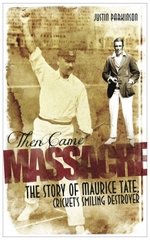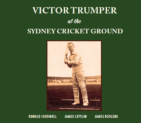Then Came Massacre: The Story of Maurice Tate, Cricket’s Smiling Destroyer
Martin Chandler |Published: 2013
Pages: 224
Author: Parkinson, Justin
Publisher: Pitch Publishing
Rating: 4 stars

Justin Parkinson feels that Maurice Tate has become a forgotten figure, and as a consequence he has written a new biography of a man who has already been the subject of two such volumes, by John Arlott in 1951, and Gerald Brodribb in 1976. The Arlott effort appeared as one of a series of short books on cricketers published by Phoenix House in the early 50s. They didn’t get past the first handful of titles, the 64 page format being, to use a well known Arlottism, neither one thing nor the other.
The Brodribb version is much more substantial, and written by a man with a deep love of the game in general, and Sussex cricket in particular. It is however very much a creature of its time, an essentially cricketing biography, rather than a detailed examination of the character of its subject.
I find it difficult to agree with Parkinson that Tate’s star in the game’s firmament is fading. He remains, with Alec Bedser, one of the two great medium fast bowlers that the game has seen, but I do accept that Tate the man is elusive, and for that reason the writing of Then Came Massacre: The Extraordinary Story of England’s Maurice Tate* was certainly worthwhile.
The book begins, as indeed did Brodribb’s, with a look at the well worn tale of Tate’s father’s one disastrous Test match in 1902, and his subsequent assertion that he had a lad at home who would one day put things right for him. After that Parkinson adopts the traditional biographer’s approach of a chronological, season by season look at his subject’s career.
Is the tale an extraordinary one? Probably not is the honest answer, but it is no less interesting for that. Tate’s early cricket career was one of modest achievement, rather surprisingly in light of what followed. He couldn’t even get into his school team let alone play a starring role. His ordinary beginnings as a county cricketer, following in his father’s footsteps as a brisk off spinner, were therefore to be expected. What was not so easily foreseen was the change that took place over the course of the 1922 season.
It is that transformation, when Tate started bowling at pace, which is presumably what is considered to be extraordinary, although a change in style by a bowler was not so unusual in those days as it is now. Admittedly the change was more frequently the other way round, pace to spin, as in Tom Goddard, Charlie Parker and even Hedley Verity, but Bill Voce was another example of a man who made a similar change to Tate.
I remember when Gus Fraser was at his best, and the occasional aging observer would, rheumy eye fixed on the rather ungainly Middlesex paceman’s action, make comparisons with Tate and particularly the way his deliveries gathered pace off the pitch. Parkinson spends an interesting chapter grappling with the science behind that particular concept, which he explains is in reality an illusion. Whether an expert in the field would agree with his views I know not, but I certainly enjoyed what was an interesting and refreshingly jargon-free explanation.
Turning to the question of what made Tate tick Parkinson’s reader learns that he was a man who did not generally appreciate criticism, and who had an uneasy relationship with many in authority. His mental health seems at times to have been somewhat fragile, and Mrs Tate was clearly a tower of strength within the family. These issues are dealt with as fully as they can be given that it is now more than half a century after Tate’s death, and that there is no one still alive who knew him well.
There is one question that the book leaves unanswered, and it is a little frustrating. The press release describes Tate as being, at the time of his death, in near poverty, but why that should be the case is never made clear. It is true that a business venture, a sports shop, failed, but that cannot be the answer as subsequent to that Tate enjoyed a benefit worth GBP100,000 in modern terms. In addition whilst he was not particularly well rewarded by the game, his income was better than most, and surely sufficient with which to support his wife and four children, and after his playing days ended he seems not to have spent any time out of work. But whatever the detailed reasons for Tate’s penury in his declining years his story, and that of his father, remain a fascinating glimpse into the lives of professional cricketers over the first half of the 20th century.
On the downside I did feel there was perhaps a little too much of the narrative devoted to the County Championship, and rather less space than might have been the case used to consider those strained relationships, particularly that with Douglas Jardine, on whose famous tour the by then veteran Tate played such a peripheral role. But those are personal quibbles, and they do not alter the fact Then Came Massacre: The Extraordinary Story of England’s Maurice Tate* is recommended reading for anyone with an interest in Maurice Tate and the era in which he played.
*This was the working title, changed prior to publication and not to my shame spotted by me in my anxiety to open the book, to Then Came Massacre: The Story of Maurice Tate, Cricket’s Smiling Destroyer






Leave a comment